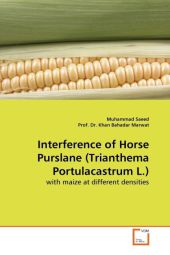 Neuerscheinungen 2010Stand: 2020-01-07 |
Schnellsuche
ISBN/Stichwort/Autor
|
Herderstraße 10
10625 Berlin
Tel.: 030 315 714 16
Fax 030 315 714 14
info@buchspektrum.de |

Bahadar Khan Marwat, Muhammad Saeed
(Beteiligte)
Interference of Horse Purslane (Trianthema Portulacastrum L.)
with maize at different densities
2010. 104 S.
Verlag/Jahr: VDM VERLAG DR. MÜLLER 2010
ISBN: 3-639-27308-7 (3639273087)
Neue ISBN: 978-3-639-27308-3 (9783639273083)
Preis und Lieferzeit: Bitte klicken
Maize is the third main cereal crop after wheat and rice in Pakistan, and second after wheat in Khyber Pukhtunkhwa. Horse purslane (Trianthema portulacastrum L) a member of family Aizoaceae, is a common weed of maize, cotton and vegetables all over Pakistan (Hashim and Marwat, 2002). Due to indeterminate habit, vegetative and reproductive growth continues for the entire life span (Nayyar et al., 2001). Out of 69 weed species T. portulacastrum was realized as the most aggressive weed of maize crop (Kumar and Singh, 1983). At a density of 12 plants m-2 of T. portulacastrum gave lower maize yield of 3.54 t ha-1 than weed-free plots 3.89 t ha-1 (Ansar et al., 1996), and infestation can lead to 32.3% losses in maize crop (Balyan and Bhan, 1989). Horse purlane caused 25 million dollars loss to maize production each year in Pakistan (PhD Thesis of Muhammad Saeed).


